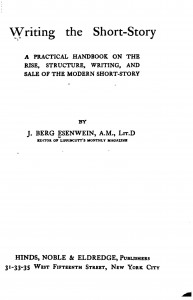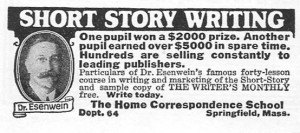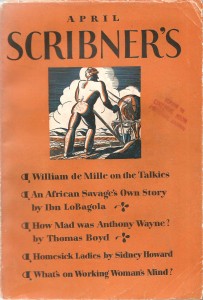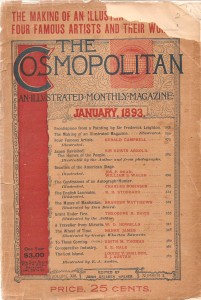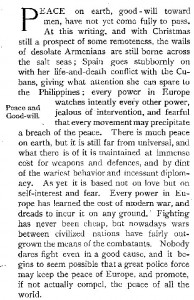Follow Scott
Recent Tweets
- Waiting for Twitter... Once Twitter is ready they will display my Tweets again.
Latest Photos
Search
Tags
anniversary Balticon birthdays Bryan Voltaggio Capclave comics Cons context-free comic book panel conventions DC Comics dreams Eating the Fantastic food garden horror Irene Vartanoff Len Wein Man v. Food Marie Severin Marvel Comics My Father my writing Nebula Awards Next restaurant obituaries old magazines Paris Review Readercon rejection slips San Diego Comic-Con Scarecrow science fiction Science Fiction Age Sharon Moody Stan Lee Stoker Awards StokerCon Superman ukulele Video Why Not Say What Happened Worldcon World Fantasy Convention World Horror Convention zombies
©2025 Scott Edelman
Writing advice from 1908—Part VI
Posted by: Scott
Tags:
old magazines
Posted date:
February 24, 2008 |
No comment
Up until now, Dr. J. Berg Esenwein’s 1908 book Writing the Short-Story: A Practical Handbook on the Rise, Structure, Writing and Sale of the Modern Short-Story has offered advice which, while it might sometimes seem quaint now that a century has passed, hasn’t attempted to steer today’s beginning writers in a direction that’s just dead wrong for 2008.
But now, here’s a tip that runs counter to everything you’d hear any professional writer or writing instructor recommend today:
Do not think it necessary to put “he saids” after every remark made by a character. So long as without them the reader understands clearly and easily just who is speaking, such additions hinder rather than help dialogue. But when you do add the explanatory verbs, use some ingenuity in getting away from the conventional forms. Do not discriminate against such good expressions as “he acquiesced,” “admitted,” “argued,” “asked,” “assented,” “boasted,” “called,” “cautioned,” “chuckled,” “corrected,” “cried,” “croaked,” “crowed,” “declared,” “drawled,” droned,” “ejaculated,” “emended,” “enjoined,” “enumerated,” “exclaimed,” “exploded,” “flashed,” “frowned,” “gasped,” “growled,” “grumbled,” “grunted,” “hinted,” “inquired,” “insinuated,” “intimated,” “jeered,” “jested,” “laughed,” “leered,” “maundered,” “mumbled,” “nodded,” “opined,” “pronounced,” “puffed,” “questioned,” “rejoined,” “retorted,” “returned,” “simpered,” “snarled,” sneered,” “snickered,” “stammered,” “stipulated,” “stormed,” “suggested,” “urged,” “volunteered,” “wondered,” “yelled,”—and a whole dictionaryful besides, each precisely suited to the shade of mood to be depicted.
This is precisely the opposite of what you should be doing. There’s nothing wrong with a simple “he said.”
So, please, writers of 2008 and beyond—keep your ejaculations where they belong!
Writing advice from 1908—Part V
Posted by: Scott
Tags:
old magazines
Posted date:
February 17, 2008 |
No comment
In Dr. J. Berg Esenwein’s 1908 book Writing the Short-Story: A Practical Handbook on the Rise, Structure, Writing and Sale of the Modern Short-Story, he not only tells us exactly what sort of story we should write, but he also gives advice as to what sort of stories we should avoid.
Here’s what was apparently off limits a century ago: (more…)
Writing advice from 1908—Part IV
Posted by: Scott
Tags:
old magazines
Posted date:
February 15, 2008 |
No comment
Rejection is eternal, but so are the very human responses of fight or flight. When that manuscript comes back, the reaction that springs up deep down in the gut, whether we are conscious of it or not, is to either tell off the editor, or to curl up in a ball in the corner and get depressed. Then we must shrug it off and go on.
So even though this may be one instance in which some things never change, it’s still useful to take a look at Dr. J. Berg Esenwein’s advice for handling those emotions from his 1908 manual Writing the Short-Story: A Practical Handbook on the Rise, Structure, Writing and Sale of the Modern Short-Story.
Here’s what he had to say about rejection: (more…)
Writing advice from 1908—Part III
Posted by: Scott
Tags:
old magazines
Posted date:
February 12, 2008 |
No comment
Following up on Dr. J. Berg Esenwein’s advice on whether it’s necessary to typewrite one’s short-story submissions and his thoughts on selling stories by paying personal visits to the editors, both cribbed from his 1908 book Writing the Short-Story: A Practical Handbook on the Rise, Structure, Writing and Sale of the Modern Short-Story, here are his thoughts on the all-important matter of getting paid.
Pay careful attention to what he has to say. One particular fact stood out for me. Let’s see whether the same thing grabs you:
If you have sold enough manuscript to warrant it, you may wish to set a price upon your story, but by doing so you run a risk. No ordinary circumstance will lead an editor to deviate from his regular rate. The fact that you have sold one or two stories at five cents a word to one magazine will not warrant your expecting another to pay you more than its accustomed honorarium. At the same time, if your minimum rate is actually five or three or two cents a word, frankly say so and abide by the consequences. If you offer a manuscript “at regular rates” do not haggle about the price after your story has been accepted. Remember that some magazines pay “on acceptance,” other pay “on publication,” while others pay not at all. …
Never put a string to your offer of a manuscript by telling the editor that you will accept his offer if it is good enough. If he is human, such a request will irritate him and may cause him to reject the story forthwith.
What struck me is that if you looked back at the cost of most things in 1908, you’d laugh. You’d chuckle about how life has changed and how cheap things were and how far we’ve come. For example, a century ago, the average annual income was $915 per year, bread was a nickle a loaf, and milk was 32 cents a gallon. You could buy a car for $500 and a house for $4,500.
And yet the price writers get for their work one hundred years later remains stable, and that’s not quite so amusing. The 1908 prices an editor might have paid are not very different from what we might be offered for our short stories today.
In 1908, you could buy a loaf of bread with a single word. How many words of short story would it take to buy a loaf of bread today?
And just try trading a 10,000-word short story for a new car!
Writing advice from 1908—Part II
Posted by: Scott
Tags:
old magazines
Posted date:
February 11, 2008 |
No comment
As I continue reading through Dr. J. Berg Esenwein’s 1908 book Writing the Short-Story: A Practical Handbook on the Rise, Structure, Writing and Sale of the Modern Short-Story (here are my first comments), I find myself drawn far more to the business side of the writing life a century ago than to any artistic advice offered.
I guess that’s because I feel that the business model of writing will always change, while the art itself is eternal. (Though I may learn differently once I dive into his century-old writing exercises.) I’m finding the differences between then and now fascinating, such as the doctor’s answer to the question: (more…)
Writing advice from 1908—Part I
Posted by: Scott
Tags:
old magazines
Posted date:
February 9, 2008 |
No comment
One hundred years ago, Hinds, Noble & Eldredge published Writing the Short-Story: A Practical Handbook on the Rise, Structure, Writing and Sale of the Modern Short-Story, by Dr. J. Berg Esenwein, editor of Lippincott’s Monthly magazine.
I’ve already shared Esenwein’s magazine ad soliciting students for his correspondence school. Now let’s travel back to 1908 to absorb some of the good doctor’s practical advice on how to crack the short-story markets of his day! (more…)
Just what the doctors ordered
Posted by: Scott
Tags:
old magazines
Posted date:
February 8, 2008 |
No comment
Writers! Are your short stories sick? Are you looking for a cure to all of your writing afflictions? Seek no further, for two doctors have the prescription for your many fiction ills.
Plucked from the pages of the April 1929 issue of Scribner’s magazine are advertisements from two doctors who are willing to show you the way to healthy prose.
First up is Dr. Esenwein, who hopes that you’ll enroll in his correspondence course in the writing and marketing of short stories. I’d never heard of Esenwein, and had no idea of the validity of his claim to be able to train his students to the point where they’d amass the talents to earn $5,000 (in 1929 dollars) in their spare time, so I figured I’d better check his credentials. A quick online search reveals Dr. Esenwein to be J. Berg Esenwein, the editor of Lippincott’s magazine and the author of the 1908 textbook Writing the Short-Story: A Practical Handbook on the Rise, Structure, Writing and Sale of the Modern Short-Story. I see that Dr. Esenwein operated out of Burlington, Massachusetts, so we now know the real reason why ReaderCon has chosen that city as its home! (more…)
The Sound and the Fury
Posted by: Scott
Tags:
old magazines
Posted date:
February 7, 2008 |
No comment
Singing in the Rain has always been one of my favorite movies, and not just because of the talented stars and amazing songs (though, of course, that’s the major reason). But I think some small part of the film’s intrigue is because it’s one of the few films detailing the painful transition as one art form supplants another. I don’t see that sort of picture happening again any time soon. I mean, how likely is it that someone’s going to write a movie musical someday about the current battle between paper books and e-books?
Singing in the Rain told the story of the Talkies taking over the screen from a distance of 1952. But what did people think at the time it was actually happening? An article in the April 1929 issue of Scribner’s gives some clues. To lay out the time frame, The Jazz Singer, starring Al Jolson, premiered on October 6, 1927, at least in the big cities, though it took around six months to be seen by the rest of the country. Based on that, and on the lead time the magazine would have required, the essay “The Screen Speaks” by William de Mille would have been written during that first uncertain year.
William de Mille was the older brother of Cecil B. DeMille and father to Agnes de Mille. He was a silent film writer, director, and producer who, according to the editorial note at the beginning of the article, “says that he will probably never direct another silent film.” So his insight into the shift is invaluable. (more…)
It’s said that the two things you should never see being made are sausages and the law, but to that list you should add magazines. It can be an ugly process. And yet the editors of The Cosmopolitan, one of the leading general-interest magazines in the country, decided to share their secrets with a lengthy article in the January issue.
That’s the January 1893 issue, as you can see by my somewhat tattered copy.
In an article titled “The Making of an Illustrated Magazine,” readers are taken through the entire publishing process, from start-up costs, to the difficulties of obtaining advertising, to that stack of unsolicited manuscripts that has existed at every magazine since the first issue of the first magazine was carved into stone tablets.
Here are a few choice excerpts from that 14-page article, which show that perhaps time really hasn’t changed things that much after all. (more…)
Christmas wishes from 1896
Posted by: Scott
Tags:
old magazines
Posted date:
December 25, 2007 |
No comment
Back in 1896, the editors of Scribner’s Magazine Illustrated had great hopes for the future. In the December issue of that year, now 111 years ago, they seemed sure that war was a thing of their past, that “it begins to seem possible that a great police force may keep the peace of Europe, and promote, if not actually compel, the peace of all the world.”
The editors felt that “peace on earth, good-will toward men” was in their future, not knowing that World War I, World War II, and all the other wars between and since were still to come. As a result, I’m afraid that I can’t be quite so sanguine about our own future. But I’ll do my best to imagine, if only for today, a world in which such hope was possible.
I’ll at least try.
Merry Christmas to you, too!

